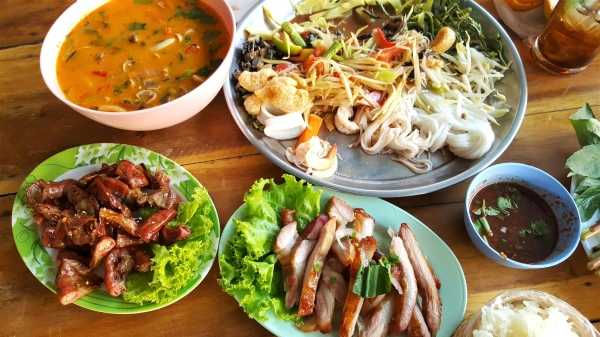
Embracing Local Ingredients and Thai Flavors
Cooking TipsKoh Samui has a vibrant culinary scene, whether you're enjoying a meal at a local restaurant or cooking at home in your vacation rental, the island offers a wealth of fresh, exotic ingredients that make cooking a joy.
Thai cuisine, renowned for its balance of sweet, salty, sour, and spicy flavors, can easily be recreated in your kitchen with a few tips and techniques. Here are some cooking tips to help you get the most out of your ingredients and prepare delicious Thai-inspired dishes while on Koh Samui.
1. Embrace Fresh, Local Ingredients
One of the best things about cooking in Koh Samui is the abundance of fresh, locally sourced ingredients. The island’s tropical climate provides access to a wide range of fruits, vegetables, and herbs that are integral to Thai cooking.
- Fresh Herbs and Aromatics: Stock up on Thai staples like lemongrass, galangal, kaffir lime leaves, Thai basil, coriander (cilantro), and mint. These herbs and spices add a fragrant, aromatic depth to dishes, from soups to curries and salads.
- Exotic Fruits: Don’t miss out on the exotic fruits available on the island, such as mangoes, papayas, pineapples, and coconuts. They can be used in sweet or savory dishes, from fresh fruit salads to tangy curry sauces.
- Vegetables: Stock your kitchen with fresh, locally grown vegetables like eggplant, pumpkin, sweet potatoes, and Thai chili peppers. These vegetables are commonly used in Thai stir-fries, curries, and soups.
- Fresh Seafood: Koh Samui is surrounded by the Gulf of Thailand, which means access to some of the freshest seafood in the region. Local markets offer a variety of fish, shrimp, prawns, crabs, and mollusks, such as snapper, mackerel, squid, and lobster. Seafood is a fundamental ingredient in many Thai dishes, from Tom Yum Goong (spicy shrimp soup) to Pla Kapong Neung Manao (steamed snapper with lime and chili). For the freshest experience, visit the local seafood markets where you can choose your ingredients right off the boat.
2. Master the Art of Balance
A hallmark of Thai cooking is its unique ability to balance sweet, salty, sour, and spicy flavors. When cooking Thai dishes, aim to achieve this perfect harmony in each dish.
- Sweetness: Palm sugar is commonly used in Thai cooking for a mild, rich sweetness that’s less intense than regular sugar. You can use palm sugar in curries, stir-fries, and even desserts like Thai sticky rice with mango.
- Saltiness: Fish sauce is a key ingredient for adding saltiness to Thai dishes. It’s used in everything from curries to dipping sauces. If you want a more delicate flavor, you can use soy sauce or salted shrimp paste as alternatives.
- Sourness: Lime juice and tamarind are often used to bring acidity and brightness to dishes. Fresh lime is especially important in salads like som tam (green papaya salad) and in soups such as tom yum.
- Spiciness: Bird’s eye chilies or Thai bird chilies are very spicy and can be used in salsas, curries, and stir-fries. Adjust the quantity to suit your taste, but be cautious as these small chilies pack a punch.
3. Learn the Basics of Thai Sauces and Pastes
Many Thai dishes rely on curry pastes and sauces that form the foundation of their flavor. Once you get familiar with a few key pastes and sauces, you can create a variety of dishes with ease.
- Green, Red, and Yellow Curry Pastes: These pastes are the base for making Thai curries, and each type offers a different flavor profile. Red curry paste tends to be milder, while green curry paste has a vibrant, fresh flavor thanks to the inclusion of herbs like basil and cilantro. Yellow curry paste is typically milder and sweeter due to the turmeric.
- Massaman Curry Paste: A milder, slightly sweet curry paste with influences from Indian cuisine. It’s often used in rich curries with beef or chicken.
- Nam Pla (Fish Sauce): Essential for adding umami and saltiness to Thai dishes. It’s used in both savory dishes and dipping sauces.
- Oyster Sauce and Soy Sauce: Often used for stir-fries, these sauces give depth and flavor to simple vegetable or meat dishes. You can also use them to marinate proteins before cooking.
4. Understand Thai Cooking Techniques
Cooking in Koh Samui gives you the perfect opportunity to experiment with traditional Thai cooking methods that are key to the cuisine’s unique flavor and texture.
- Stir-Frying: Stir-frying is a quick and high-heat method often used in Thai cooking. It’s common to see ingredients such as meat, seafood, and vegetables cooked in a wok with a small amount of oil. The key is to keep everything moving in the wok to ensure even cooking and to avoid burning. Stir-frying is perfect for dishes like pad Thai, pad see ew, and stir-fried basil chicken.
- Grilling: Grilled food is another popular preparation method, especially for meats like chicken and pork. A common dish is Gai Yang, or Thai grilled chicken, marinated with lemongrass, turmeric, and other aromatic spices. You can even grill fruits like pineapple for a caramelized, smoky flavor.
- Steaming: Thai cuisine uses steaming as a gentle way to cook fish and other delicate proteins, preserving moisture and nutrients. You can steam fish with herbs and spices or make classic Thai dumplings and desserts like sticky rice with mango.
5. Try Cooking Thai Street Food at Home
One of the joys of Koh Samui is the chance to try street food, and many of the island’s famous dishes can be recreated at home with the right ingredients. Here are a few iconic Thai street foods you can try:
- Pad Thai: This quintessential Thai street food is made with rice noodles, stir-fried with tofu, shrimp, or chicken, along with peanuts, bean sprouts, and lime. It’s the perfect dish to practice balancing flavors, with the addition of tamarind, fish sauce, sugar, and chili.
- Som Tam (Green Papaya Salad): A refreshing and spicy salad made from shredded green papaya, tomatoes, chilies, peanuts, and fish sauce. The ingredients are pounded together in a mortar and pestle to create a beautifully textured dish.
- Satay: Skewered meats (usually chicken, pork, or beef) are marinated in a flavorful mix of spices, then grilled and served with a rich peanut dipping sauce.
- Thai Spring Rolls: These light and crunchy rolls are made with rice paper, filled with fresh vegetables, shrimp, or pork, and served with a sweet chili dipping sauce.
6. Coconut Milk and Coconut Water
Coconut milk is a staple in many Thai curries and desserts. It adds richness and a subtle sweetness to dishes like Massaman curry and Tom Kha Gai (chicken coconut soup). On the other hand, coconut water is a refreshing drink that you can enjoy on its own or use to hydrate your dishes.
When cooking with coconut milk, it’s essential to use full-fat coconut milk for a creamier texture, especially in soups and curries. The lighter versions of coconut milk are often used for beverages or as a base for smoothies.
7. Explore Traditional Thai Desserts
Thai desserts are unique and often feature tropical fruits and coconut. Here are a few popular ones to try:
- Sticky Rice with Mango: This classic Thai dessert combines sweet coconut milk-infused sticky rice with fresh, ripe mangoes.
- Khanom Krok: These coconut-filled, bite-sized pancakes are crispy on the outside and soft on the inside. Often found at street food stalls, they’re a sweet and savory treat.
- Tapioca with Coconut Milk: A delicious dessert made from tapioca pearls, coconut milk, and sugar, often served warm or chilled.
Cooking in Koh Samui offers the perfect opportunity to explore the rich flavors of Thai cuisine using fresh, local ingredients. With a special emphasis on fresh seafood, as well as vibrant herbs, fruits, and vegetables, you can recreate a variety of mouth-watering dishes right in your own kitchen.
From street food favorites to vibrant curries and refreshing desserts, Koh Samui provides a culinary adventure that’s just waiting to be discovered.
Fresh, Local ingredients, Cooking Techniques



